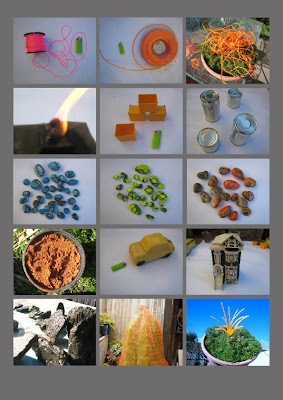La Pok Escapes invites others to perceive the world
through an alternate lens, challenging pre conceived notions of how our environments
should look, what they can be made of and where they can be.
 This work ApokAfari is a mind-scape, a place that you can not physically inhabit, but a departure point for the imagination, promoting viewers to escape into their own Pok world dream. The intention of this work is to test techniques of how to add colour into the landscape, using a mixed medium approach to garden design. Merging the synthetic materials with plants to achieve an unreal Milieu.
This work ApokAfari is a mind-scape, a place that you can not physically inhabit, but a departure point for the imagination, promoting viewers to escape into their own Pok world dream. The intention of this work is to test techniques of how to add colour into the landscape, using a mixed medium approach to garden design. Merging the synthetic materials with plants to achieve an unreal Milieu.
Having a window bay for the space of my installation, I immediately thought of Trompe L'oeil, which are often a landscape and window frame painted on a wall to allude that the space is bigger than it is.
Material Selection
I began this process by making a possible material list of things that I had around the house. The requirements for these materials where that they are water resistant and or bright in colour.
To create a mini landscape I approached my plant selection the same as I would a normal garden, looking for a variety of different scales, from grasses or ground covers, to shrubs then trees. All of which had to look like a scaled down version of a life-size specimen. I was also looking for interesting colours and shapes. I restricted myself to prodominately succulents as I knew they would remain the same once I had cut there roots back to get them into the planter.
As the space dosen’t get any direct light if the work was to be permanent then I would have selected different plants, but for the 10 day period of the show they would be fine.
As the space dosen’t get any direct light if the work was to be permanent then I would have selected different plants, but for the 10 day period of the show they would be fine.
With these materials in mind I then began to sketch out possible designs, thinking about colour and textural adjacency.
Modular System
As I wanted to establish the plants in the planter before the show and to reduce installation time on site, it was important that the garden be split up into sections. It was also impossible to bring the garden into the space in one section as the base had to go on its side to get into the window bay. Once I had the base made for the work, I looked for containers that would fit into this space. Having the garden split into five areas then informed the final design.
To make keep larger plants in place, a base was wire to the plant, then the base was wired to the box it was positioned in.
Scene Background
For the background I have used coreflute sheeting. I could get this in 3 x1200 x 2400mm. I chose this material as it is water proof and bends easily. To cover the entire background I had to use three sheets. I originally wanted a gridded background over entire skyline. To make shore the three sheets looked good together I ended up making the sky in the middle sheet different so it didn't have to line up with the other. This design also lead the eye up into the sky towards the lane above.
For the background I have used coreflute sheeting. I could get this in 3 x1200 x 2400mm. I chose this material as it is water proof and bends easily. To cover the entire background I had to use three sheets. I originally wanted a gridded background over entire skyline. To make shore the three sheets looked good together I ended up making the sky in the middle sheet different so it didn't have to line up with the other. This design also lead the eye up into the sky towards the lane above.
Lighting Experiment
As the installation is behind a window I couldn't light the mind-scape from inside the gallery as it would reflect. For this reason I began testing options for portable lights placed inside the work. In this test I used Led lights and a Tiki touch.
Installed on site

Leading the work out of the gallery and into the urban fabric I installed a hanging garden above the mind scape in the lane above. This was to firstly to lead people above the window bay so they looked down from the lane. This was also an attempt to help people make a correlation between other works I have installed in the street and my work in the gallery.
Thanks to the people who put on the Brunswick show. I
had a lot of fun making the installation and checking out all the other
works. The show is still open until the 13 of September at Donkey Wheel
House 613 Bourke St Melbourne CBD so go have a look see. http://thebrunswickshow.com




















































